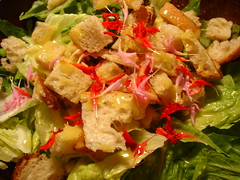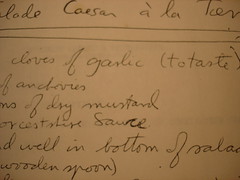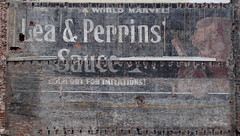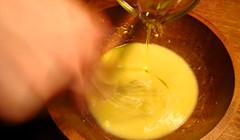On Caesar Salad
In my mind, one of the problems with contemporary food culture is what I would call “nomination anxiety,” or a fear of naming. We live in a no-nonsense, consumer-oriented, overly descriptive age, when the complexity of a dish is indicated not by the poetry of the name that is given to it, but by the number of hyphens, commas, and “with”s its name includes. The days when simple yet suggestive names like Clams Casino proliferated are largely gone, in their place we have things like “Baked Open-Faced, Hard-Shelled Clams Gratinée with Bacon and Pepper-Garlic-Oregano Salsa.” This problem is not unlike one that Anthony Lane brings up in his riotously funny review of Star Wars: Episode III—Revenge of the Sith in the May 23 issue of The New Yorker: “All those who concoct imagined worlds must populate and name them, and the resonance of those names is a fairly accurate guide to the mettle of the imagination in question.” Lane then goes on to compare the “flinty perfection” of J.R.R. Tolkien’s Mordor and Orc, with the work of George Lucas: Mace Windu, Bail Organa, Sith, and so on.
This brings me to the topic of Caesar Salad. The most generally accepted account of the origins of its name goes as follows. Caesar Cardini operated a hotel (one that bore his name) in Tijuana that was a popular watering hole and resort destination for California’s elite, including the Hollywood Babylon set. On the Fourth of July, 1924, faced with an unexpected rush and a lack of ingredients other than salad fixings, he invented a salad that involved Romaine lettuce, croutons, Parmesan cheese, and a zesty, garlicky dressing with an olive oil, raw egg, and lemon juice base in an attempt to sate the hungry crowd. The salad was a hit and became a fixture of his menu, and the glitterati that frequented his hotel and restaurant soon spread its fame around North America and then around the world. Whether or not this story is in fact accurate—there are numerous other stories floating around, including several of which that claim Cardini essentially stole the recipe—the Hotel Caesar was definitely one of its points of origin, many got their first taste of the salad there (including Julia Child, who visited the restaurant with her parents as a, um, child), and Cardini did much to try and capitalize on the fame of the dish, including opening a restaurant in Los Angeles, and bottling his dressing for retail sale in the years that followed World War II. By 1953, the recipe was being fêted by the Society of Epicures in Paris as “the greatest recipe to originate from the Americas in 50 years.” The story behind its name might have been fairly straightforward, but its name was made up of all kinds of powerful associations—of Italy and “Italian-ness,” of the beginnings of the Roman Empire, of 20th century cosmopolitanism, even of organized crime—and it quickly became the stuff of mythology.
Flash forward to the early 1970s. Caesar Salads’s fame had continued to grow, but it still hadn’t become ubiquitous yet. It was still the kind of dish that distinguished the big city from the provinces, and it was an essential part of the repertoire of those who loved food and loved to entertain, including my parents. We were living in Ottawa at the time, between stints in the San Francisco Bay Area, and Caesar Salad was one of my parents’ showstoppers.
The recipe they used had been given to them by their friend Terry, and I distinctly remember the ritual involved in preparing it: taking out the huge, oblong wooden salad bowl that was my dad’s preferred vehicle for his Caesar Salad, crushing the garlic and anchovies in the base of the bowl with a wooden spoon, whisking in first the egg and then the olive oil. I liked to watch Caesar Salad being made almost as much as I liked eating it.
Last night we went back to the “Salade Caesar à la Terry” recipe that I’ve been toting around since I left home and went off to college as a teenager. We don’t have a big oblong wooden salad bowl, but we do have a couple of nice round ones. This recipe makes enough salad dressing for a huge salad, but instead of halving it or even quartering it, I just mixed up the full recipe in our bowl to properly season it, then poured the dressing into a jar, before seasoning the salad appropriately and then putting the remaining dressing in the refrigerator for later Caesar Salads. “Salade Caesar à la Terry” is a classic recipe, with a healthy amount of garlic and anchovies (which may not have been a part of Cardini’s original recipe, except in the form of Worcestershire Sauce), olive oil and lemon juice but no vinegar. The only change we made to it was that we added some Bee Balm blossoms to give the salad some color as well as a shot of peppery flavor, but mostly because we just happened to have some kicking around in our refrigerator [see "La Monarde," below]. God, it was delicious. We felt like those patrons of Hotel Caesar on that fateful Fourth of July back in 1924—we couldn’t get enough.
Without further ado:
Salade Caesar à la Terry
1-4 cloves of garlic, minced or pressed (to taste—we were always a 4-clove family)
3-6 anchovy filets (to taste—we used 4, but the next time I think I’ll use 6)
1-2 tsp of dry mustard (to taste—we used 2)
1 tsp Lea & Perrins’ Worcestershire Sauce
1-3 oz lemon juice (to taste—we used 1)
1 egg, beaten
3/4 – 1 cup olive oil (we used 3/4)
Parmesan cheese to taste
Salt and freshly ground black pepper to taste
Garlic croutons (sautéed in olive oil with garlic)
1 head Romaine lettuce, or 1 package Romaine lettuce hearts, depending on the season
Place the garlic, the anchovies, the dry mustard, and the Worcestershire Sauce in the bottom of a wooden salad bowl and crush with a wooden spoon. Add the lemon juice and stir. Add the egg and blend with a wire whisk. Pour in the olive oil in a steady stream, whisking the whole while. Add salt and pepper to taste.
Pour the dressing into a jar. Place the Romaine lettuce (broken into manageable pieces) into the seasoned bowl. Add the croutons and the grated Parmesan cheese. Dress the salad with an appropriate amount of the dressing (again, this recipe makes a large amount of the dressing, enough for a big dinner party). Save the remaining dressing in the refrigerator.
Serve as an appetizer, or as a meal with a crusty loaf of bread, a cheese plate, and a crisp white wine.
aj













6 comments:
Sounds like a very good dressing and I just happen to have Romaine lying around...
Hi Ana,
Say no more: sounds like a natural. I hope you enjoy it...
yummmmmmmmmmmmmmmmmy
Oh yum! Glad to see you are fellow 4-clove adherents. Something about people who don't like too much garlic in their caesar make me wary... ;) Thanks for sharing the recipe - I'll definitely try it.
Caesar Salad a la Terry in the 70's in Ottawa was something else!
R&J
and it still is!
Post a Comment